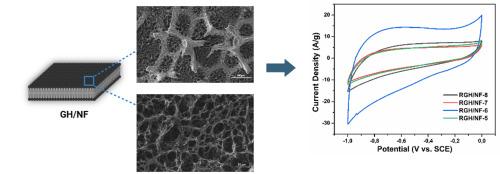Architecting 3D carbon networks: A binder-free route to high-performance energy storage
IF 7.9
2区 工程技术
Q1 CHEMISTRY, PHYSICAL
引用次数: 0
Abstract
Achieving high capacitance, fast charge-discharge capability, and cycle stability simultaneously in supercapacitor electrodes remains a critical challenge for next-generation energy storage. Here, we present a three-dimensional (3D) reduced graphene hydrogel (RGH) architecture directly bonded to nickel foam (NF) via an optimized simple reduction process without the use of a binder. The resulting RGH/NF electrode exhibits the highest specific surface area (2424.5 m2 g−1) reported to date for graphene-based systems, forming interconnected ion channels and a continuous conductive network at the RGH-NF interface. This unique structure provides a record-breaking specific capacitance of 1.208 F/g at 5 mV s−1, significantly outperforming conventional graphene electrodes. It demonstrates exceptional durability with a capacitance retention rate of 94.6 % after 10.000 cycles at 3 A g−1. When configured as a symmetric supercapacitor, the device achieves an unprecedented combination of energy density (145 Wh kg−1) and power density (1.09 kW/kg), outperforming most reported carbon-based systems. These results position 3D RGH, which grows directly on metal frameworks, as a scalable and highly effective strategy for high-performance energy storage technologies.

构建3D碳网络:通往高性能能源存储的无粘合剂路线
在超级电容器电极中同时实现高电容、快速充放电能力和循环稳定性仍然是下一代储能的关键挑战。在这里,我们提出了一种三维(3D)还原石墨烯水凝胶(RGH)结构,通过优化的简单还原工艺直接结合到泡沫镍(NF)上,而不使用粘合剂。所得到的RGH/NF电极显示出迄今为止基于石墨烯的系统中最高的比表面积(2424.5 m2 g−1),在RGH-NF界面形成相互连接的离子通道和连续的导电网络。这种独特的结构在5 mV s−1下提供了创纪录的1.208 F/g比电容,显著优于传统的石墨烯电极。它具有优异的耐用性,在3ag−1下经过10,000次循环后的电容保持率为94.6%。当配置为对称超级电容器时,该器件实现了前所未有的能量密度(145 Wh kg−1)和功率密度(1.09 kW/kg)的组合,优于大多数报道的碳基系统。这些结果将直接生长在金属框架上的3D RGH定位为高性能储能技术的可扩展和高效策略。
本文章由计算机程序翻译,如有差异,请以英文原文为准。
求助全文
约1分钟内获得全文
求助全文
来源期刊

Journal of Power Sources
工程技术-电化学
CiteScore
16.40
自引率
6.50%
发文量
1249
审稿时长
36 days
期刊介绍:
The Journal of Power Sources is a publication catering to researchers and technologists interested in various aspects of the science, technology, and applications of electrochemical power sources. It covers original research and reviews on primary and secondary batteries, fuel cells, supercapacitors, and photo-electrochemical cells.
Topics considered include the research, development and applications of nanomaterials and novel componentry for these devices. Examples of applications of these electrochemical power sources include:
• Portable electronics
• Electric and Hybrid Electric Vehicles
• Uninterruptible Power Supply (UPS) systems
• Storage of renewable energy
• Satellites and deep space probes
• Boats and ships, drones and aircrafts
• Wearable energy storage systems
 求助内容:
求助内容: 应助结果提醒方式:
应助结果提醒方式:


